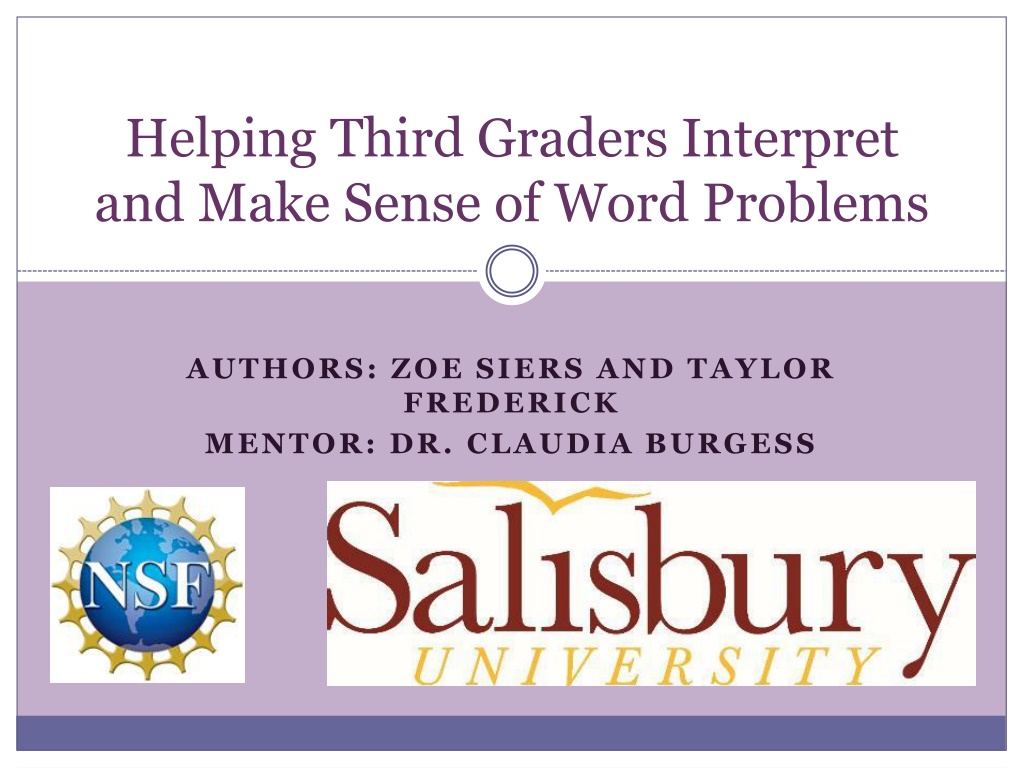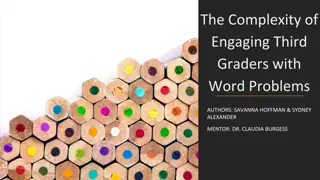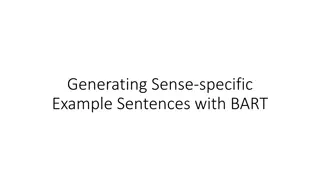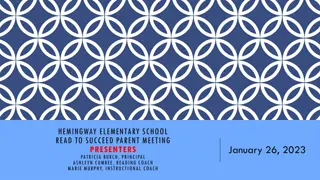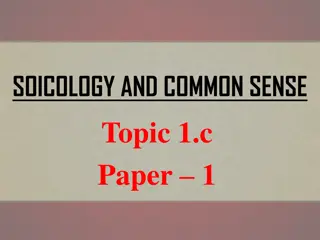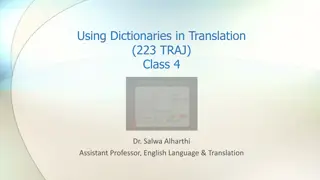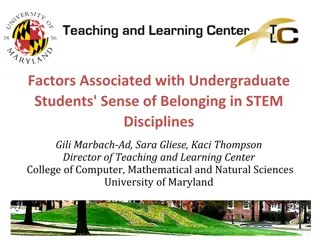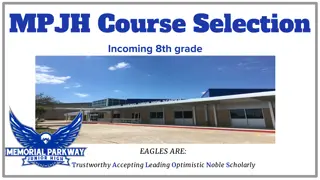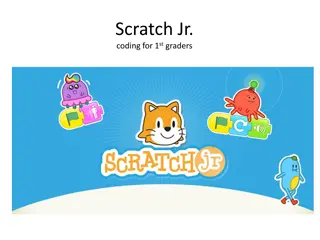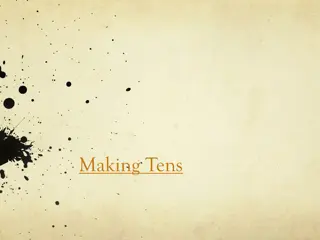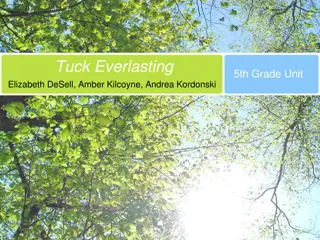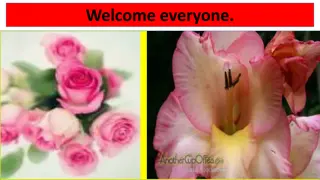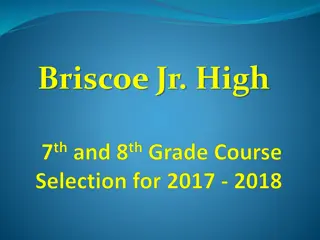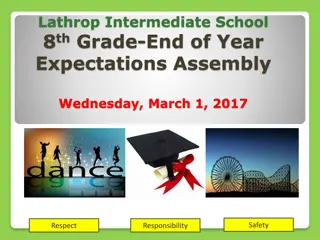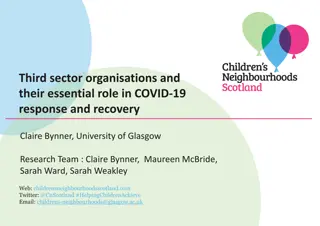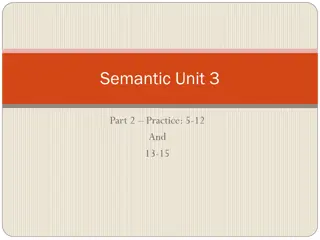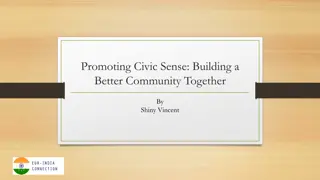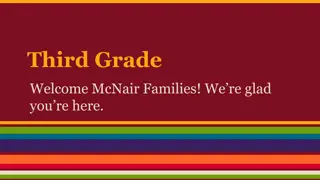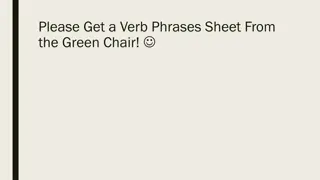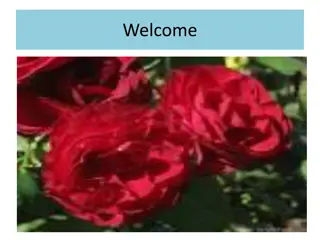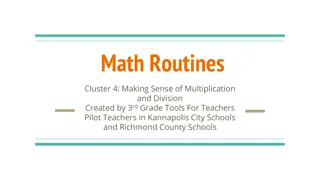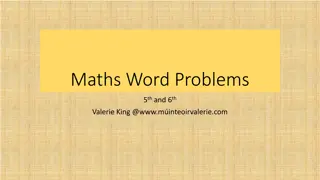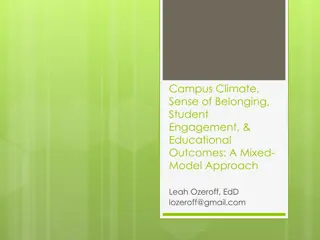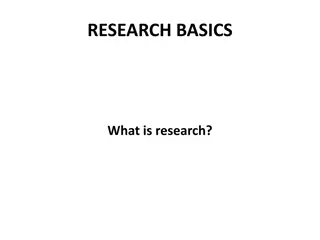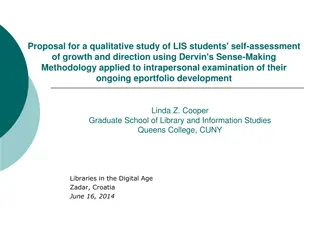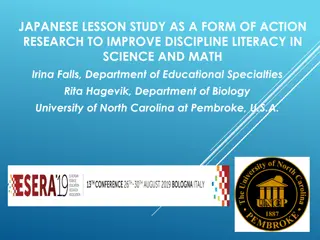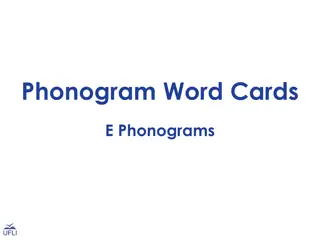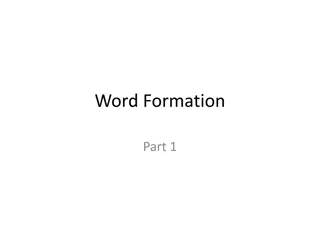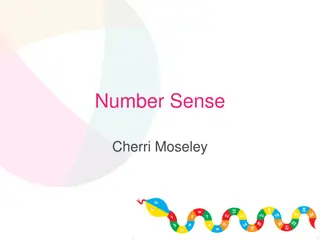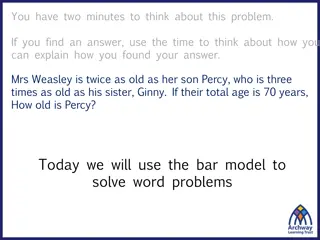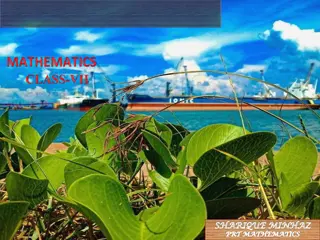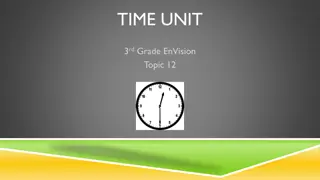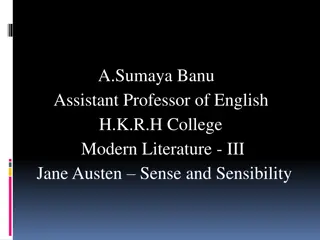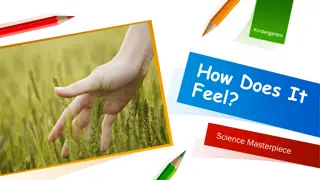Helping Third Graders Make Sense of Word Problems: A Research Study
Research explores challenges students face in engaging with word problems, highlighting the need to enhance problem-solving strategies. The study investigates students' problem-solving approaches before, during, and after instruction to determine changes in strategies over time. Using a literature-based teaching approach and a structured curriculum framework, the study aims to improve students' mathematical understanding through targeted interventions and assessments.
- Research Study
- Word Problems
- Problem-Solving Strategies
- Curriculum Framework
- Literature-Based Teaching
Download Presentation

Please find below an Image/Link to download the presentation.
The content on the website is provided AS IS for your information and personal use only. It may not be sold, licensed, or shared on other websites without obtaining consent from the author. Download presentation by click this link. If you encounter any issues during the download, it is possible that the publisher has removed the file from their server.
E N D
Presentation Transcript
Helping Third Graders Interpret and Make Sense of Word Problems AUTHORS: ZOE SIERS AND TAYLOR FREDERICK MENTOR: DR. CLAUDIA BURGESS
Introduction Research indicates that students struggle to engage with word problems (Hunt, 2014). This is due to: Schools emphasizing routine word problems that do not connect solutions to context (Nosegbre- Okoka, 2004). Schools assigning a limited, narrow range of problems for students to solve (Christou & Philippou, 1998).
Introduction Purpose: To investigate how a group of students entering third grade made sense of multiple types of word problems (Common Core State Standards Initiative, 2010) and to design an instructional sequence to help develop an array of problem-solving strategies. Specific Research Questions: Which strategies do students use to solve word problems before, during, and after the instructional sequence? 2. To what extent, and how, do the students strategies change and develop over the course of instruction? 1.
Curriculum Framework: o Instructional goals for our sessions were drawn from the Confrey et al. (2012) learning progressions for Grade 2 Operations and Algebraic Thinking. These goals serve to focus children s attention on addition and subtraction word problems and using mental strategies.
Literature-Based Teaching Strategies How to help students with word problems: Elicit students interpretations of problems (Dominguez, 2016). Use manipulative representations and diagrams (Murata & Stewart, 2017). Encourage students to make sense of word problems rather than relying on key-word approaches (Nosegbe- Okoka, 2004).
Methodology: Participation Participants: Four students (3 female, 1 male) Student pseudonyms: Justin, Jessa, Jill, and Joy All students were transitioning from Grade 2 to Grade 3 Students were assessed with 30 minute pre and post-interviews Jessa and Jill missed one of the weekly sessions.
PATHWAYS Instructional Cycle: Interact with children to gather data on their mathematical understanding. PATHWAYS Instructional Cycle: Procedure: Transcribe and analyze video interactions to identify children s learning needs. Try the lesson with a group of peers and faculty members and refine it based on their feedback. o The cycle shown was repeated nine times. o We coded the data collaboratively to qualitatively identify student reasoning patterns. Create a problem- based lesson to address students learning needs.
Key Task 1 15 APPLES WERE IN A BASKET. JOSE PUT SOME MORE APPLES IN THE BASKET AND NOW THERE ARE 26. HOW MANY APPLES DID JOSE PUT IN THE BASKET?
Key Task 2 ANNA HAD 43 LEGO PIECES. SHE GIVE SOME TO ALICIA AND NOW SHE HAS 19. HOW MANY LEGO PIECES DID ANNA GIVE AWAY?
Key Task 3 SOME CHILDREN ATTENDED A BIRTHDAY PARTY. AT 3 OCLOCK, 14 CHILDREN WENT HOME AND THEN THERE WERE 21 CHILDREN AT THE PARTY. HOW MANY CHILDREN ATTENDED THE BIRTHDAY PARTY?
Jessa Justin Initial Assessment Results o During the pre- interview, each student solved the problems using various methods. She used a number sentence, a hundreds chart, and then an open number line to solve the problem. He created a t-chart with double digit numbers to organize and decompose tens and ones.
Initial Assessment Results Continued Joy Jill She used a keyword strategy in Key Task 3 and added the two numbers because it said how many. We believe she subtracted 21 because the problem stated that the children went home. Jill used the counting-on strategy to solve word problems. Key Task 1: Jill: I counted. I started at 15. (she then counted on to 26)
Lesson 1: Modeling Strategies for Word Problems Introductory lesson into making sense of word problems by using an acronym that helped students organize their thinking. Numbers What numbers are involved Looking For What are we looking for? Wyatt Who is involved? Doing What are they doing? What s What is going on? Students responded well to the looking for question in the acronym.
Lesson 2: Making Sense of Word Problems with Clues Students explained their thought processes for solving one-step word problems involving addition and subtraction. Joy, Jill, and Jessa all showed conceptual understanding of place value. Jill showed a new type of thinking by setting up a number sentence and treating it like an algebraic equation.
Lesson 3: Solving Open Tasks and Acting Out Problems We put the students names into word problems to help them think about acting out problems and contextualizing their answers. Joy has _ gummy bears to eat during the movie. Jill has _ gummy bears to eat. How many more gummy bears does Joy have? Justin related his answers back to the context, however Jill, Jessa and Joy all had difficulties choosing appropriate mathematical operations for the context.
Lesson 4: Word Problems with Extraneous Numbers Students were given a word problem containing some numbers that were not needed to solve it. Mary s birthday was on the 4th of July. She turned 9. Her party was at 17 Dusty Way. At 3 o clock there were 10 boys and some girls swimming in the pool. At 5 o clock, some more girls came to swim. Now there are 20 girls swimming in the pool. How many more girls came at 5 o clock than at 3 o clock? All students struggled to connect their operations with the context. In particular, Jill gave an answer to a question with no explanation as to why she choose her answer.
Lesson 5: Solving a Word Problem with Two Answers Students were given a word problem with two correct answer. After students offered their own solutions, they had to decide if the solution presented by a puppet was correct or not. Joy, Jill and Justin were all able to leverage the context of the problem to make sense of potential solutions to the task.
Lesson 6: Word Problems by Using Play Students built word problems through a Notice and Wonder activity involving a bowl of fruit. Justin: Uh I had BLANK fruits and vegetables. I got BLANK more. How many do I have now? Students watched the teachers perform a skit and then participated in acting out two word problems and had to determine which word problem matched the skit performed by the teachers.
Lesson 7: Students create a word problem as a class in the Notice and Wonder activity and had difficulty connecting an operation to the word problem. Students acted out three word problems as a class and solved them immediately following their performances.
Joy and Jessa: Jill Post- Both continued to rely on number sentences and hundreds charts. However, they were able to pull details from the context of the problem to help them justify their operations and verbalize the reasoning behind their answers. She continued to use the counting-on strategy in the post-interview. She was able to communicate contextual details from the word problem and use them to support her mathematical operations when solving key tasks. Assessment Results o At the end of the study, each student showed significant progress as seen in the post-interviews. Justin: He was able to write answer sentences that connected his answer back to the word problem. He also strayed away from decomposing numbers using a t-chart, and instead relied on hundreds charts and invented strategies in the post- interview.
Reflection and Discussion After analyzing and collecting data, the following was apparent: It was challenging for elementary students to meet the Confrey et al. (2012) learning progressions for the Common Core. It was difficult for students to comprehend and make sense of word problems. Initially, students heavily relied on keyword strategies, selecting random numbers in problems, and choosing operations without understanding what the problem was asking.
Reflection and Discussion Continued We recommend: Students acting out word problems in order for them to develop a deeper understanding of what the problem is asking and aid them in putting their solutions back into the context of the problem. We found that explaining strategies verbally, using base-ten models, and writing their own equations furthered students conceptual understanding of word problems.
References C H R I S TO U , C . , & PH I L I PPO U , G . ( 1 9 9 8 ) . T H E D E V E L O PM E N TA L N AT U R E O F A B I L I T Y TO S O LV E O N E - S T E P W O R D PR O B L E M S . J O U R N A L F O R R E S E A R C H I N M AT H E M AT I C S E D U C AT I O N , 2 9 ( 4 ) , 4 3 6 - 4 4 2 . C O M M O N C O R E S TAT E S TA N D A R D S I N I T I AT I V E . ( 2 0 1 0 ) . C O M M O N C O R E S TAT E S TA N D A R D F O R M AT H E M AT I C S . R E T R I E V E D FR O M H T T P: / / W W W. C O R E S TAN D AR D S . O RG / M AT H C O N FR E Y, J . , N G U Y E N , K . H . , L E E , K . , PA N O R K O U , N . , C O R L E Y, A . K . , & M A L O N E Y, A . P. ( 2 0 1 2 ) . T U R N O N C C M AT H . N E T: L E A R N I N G T R A J E C TO R I E S F O R T H E K - 8 C O M M O N C O R E M AT H S TA N D A R D S . R E T R I E V E D FR O M H T T P: / / W W W. T U R N O N C C M AT H .N E T D O M I N G U E Z , H . , ( 2 0 1 6 ) . M I R R O R S A N D W I N D O W S I N TO S T U D E N T N O T I C I N G . T E A C H I N G C H I L D R E N M AT H E M AT I C S , 2 2 ( 6 ) , 3 5 9 - 3 6 5 . H U N T, J . B . ( 2 0 1 4 - 2 0 1 5 ) . PR O B L E M S W I T H O U T N U M B E R S . T E A C H I N G C H I L D R E N M AT H E M AT I C S , 2 1 ( 5 ) , 3 2 0 . M U R ATA , A . , & S T E WA RT, C . ( 2 0 1 7 ) . FA C I L I TAT I N G M AT H E M AT I C A L PR A C T I C E S T H R O U G H V I S U A L R E PR E S E N TAT I O N S . T E A C H I N G C H I L D R E N M AT H E M AT I C S , 2 3 ( 7 ) , 4 0 5 - 4 1 2 . N G, S . F, & L E E , K. ( 2 0 0 9 ) . T H E M O D E L M E T H O D : S I N GA PO R E C H I L D R E N S TO O L FO R R E PR E S E N T I NG A N D S O LV I N G A L G E B R A I C W O R D PR O B L E M S . J O U R N A L F O R R E S E A R C H I N M AT H E M AT I C S E D U C AT I O N , 4 0 ( 3 ) , 2 8 2 - 3 1 3 . N O S E G B E - O K O K A , C . ( 2 0 0 4 ) . A S E N S E - M A K I N G A PPR O A C H TO W O R D PR O B L E M S . M AT H E M AT I C S T E A C H I N G I N T H E M I D D L E S C H O O L , 1 0 ( 1 ) , 4 1 - 4 5 .
